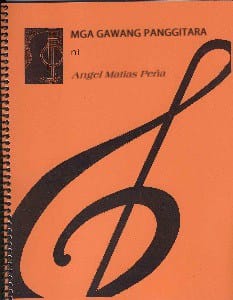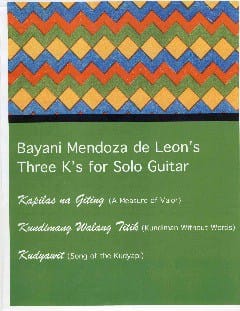Publications

Mga Gawang Panggitara ni Angel Matias Peña
(The Guitar Works of Angel Matias Peña)
Featuring 10 solos and a guitar trio (in 3 movements)
Angelito has collaborated with Maestro Angel Peña since 2006 and gave the premiere performances of the composers works for solo guitar. This publication puts in print Maestro Peña’s output for solo guitar as well as a work for guitar trio.
Bayani Mendoza de Leon’s
Three K’s for Solo Guitar
Kapilas na Giting (A Measure of Valor)
Kundimang Walang Titik (Kundiman Without Words)
Kudyawit (Song of the Kudyapi)
This publication features the first 3 guitar solos written by Bayani Mendoza de Leon. Kapilas na Giting was written for Filipina guitarist Agnes Narciso in 1975 who gave the premiere performance of the work in Alicante, Spain. It took 25 years before the composer would write again for solo guitar. Kudyawit was written in the year 2000 and was commissioned by Angelito Agcaoili and the Philippine Association for Graduate Education of Arizona State University. This was followed by Kundimang Walang Titik which was written in 2001 and was commissioned by Angelito Agcaoili and the Phoenix Philippine-American Lions Club.
“The most compelling compositions were those by Bayani de Leon. His Kapilas na Giting is a very powerful work, despite it’s brevity.”
-James Reid, GFA Soundboard Vol. XXX no. 1, 2004 from the review of Angelito Agcaoili’s CD recording La Guitarra Filipina


In Preparation (coming soon)
Bayani Mendoza de Leon’s Batang Laro (Child Play Suite)
a suite in 7 movements
Batang Laro, a child play suite for solo guitar, was inspired by animated scenes of children playing native Philippine games in the composer’s imagination. The rhythmic motifs were drawn essentially from Philippine folk dances ranging from the tuppaya-patung of the Igorots (northern Philippine tribe), the habanera, polka, balitaw, jota, and moro-moro of rural folks in Central Luzon and the Visayas, and the inagung and tinambul of Mindanao. The composer made liberal use of these rhythms, incorporating them into his own original dance-like melodies. As such, the various pieces in this suite can lend themselves to choreographic inventions that can be performed with the music, along the lines of Philippine children’s games specified in each number.
This work was commissioned by Angelito Agcaoili and Manuel Soriano.
